seats AUDI R8 SPYDER 2015 Owners Manual
[x] Cancel search | Manufacturer: AUDI, Model Year: 2015, Model line: R8 SPYDER, Model: AUDI R8 SPYDER 2015Pages: 232, PDF Size: 58.36 MB
Page 4 of 232
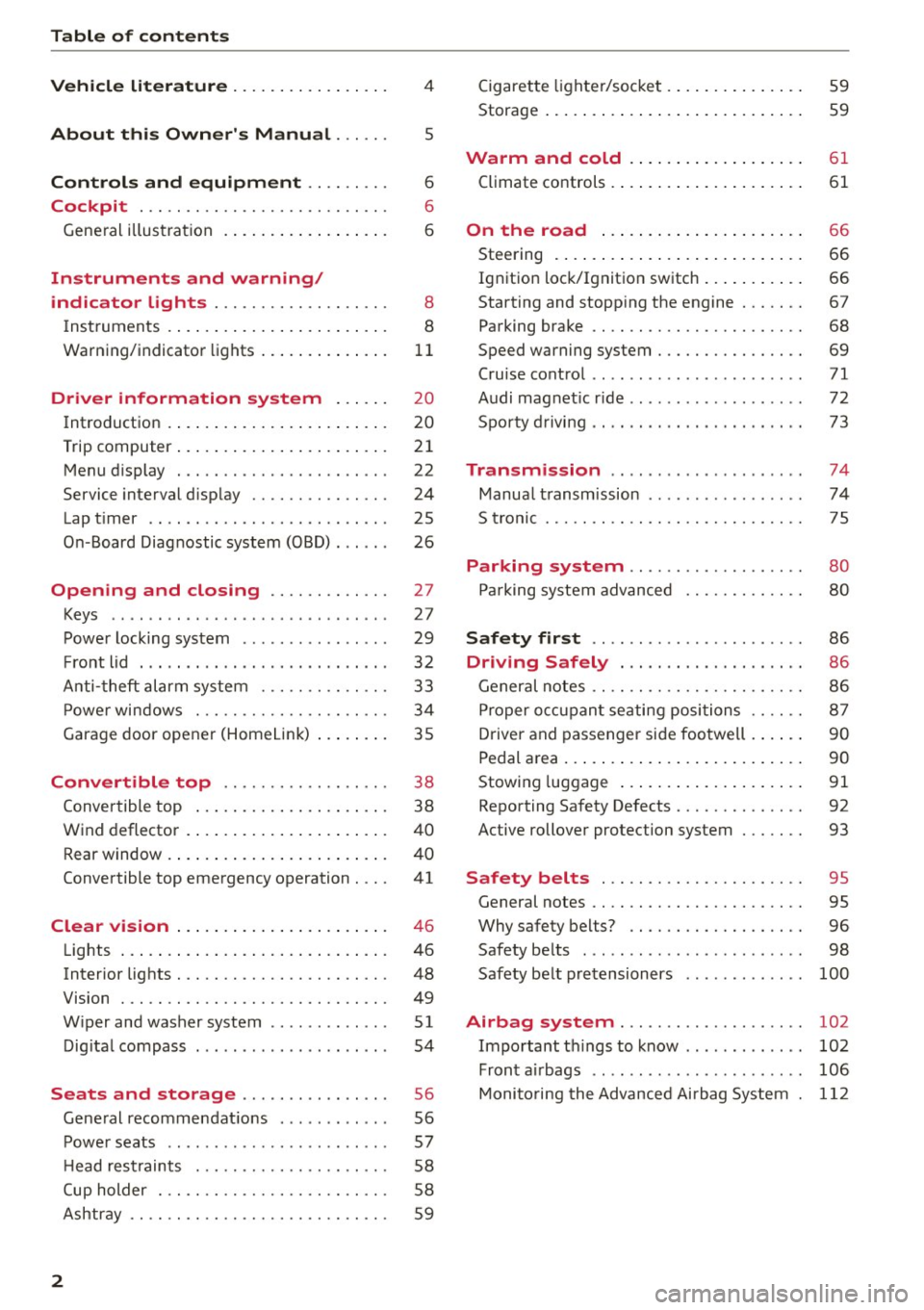
Table of contents
Vehicle liter ature ..... ... .. .. .. .. .
4
About this Owner's Manual . . . . . . 5
Controls and equipment . . . . . . . . . 6
Cockpit . . . . . . . . . . . . . . . . . . . . . . . . . . . 6
Gene ral illus trat ion . . . . . . . . . . . . . . . . . . 6
Instruments and warning/
indicator lights . . . . . . . . . . . . . . . . . . .
8
Instruments . . . . . . . . . . . . . . . . . . . . . . . . 8
Warning/ indicato r lights . . . . . . . . . . . . . .
11
Driver information system . . . . . . 20
I ntroduct ion . . . . . . . . . . . . . . . . . . . . . . . . 2 0
Trip computer ... .. . ..... ... .. .. .. ...
2 1
Menu display . . . . . . . . . . . . . . . . . . . . . . . 22
Service interval disp lay . . . . . . . . . . . . . . . 24
Lap t imer . . . . . . . . . . . . . . . . . . . . . . . . . . 25
On -Board Diagnostic system (OBD) . . . . . . 26
Opening and closing . . . . . . . . . . . . . 27
Keys . . . . . . . . . . . . . . . . . . . . . . . . . . . . . . 27
Powe r locking system . . . . . . . . . . . . . . . . 29
Fr ont lid . . . . . . . . . . . . . . . . . . . . . . . . . . . 32
Anti- theft alarm system . . . . . . . . . . . . . . 33
P ower windows . . . . . . . . . . . . . . . . . . . . . 34
Garage door opener (Homelink) . . . . . . . . 3 5
Convertible top . . . . . . . . . . . . . . . . . . 38
Conver tible top . . . . . . . . . . . . . . . . . . . . . 38
Wind deflector . . . . . . . . . . . . . . . . . . . . . . 4 0
Rear window . . . . . . . . . . . . . . . . . . . . . . . . 40
Convertible top emergency operation . . . .
41
Clear vision . . . . . . . . . . . . . . . . . . . . . . . 46
Lights . . . . . . . . . . . . . . . . . . . . . . . . . . . . . 4 6
Interior lights . . . . . . . . . . . . . . . . . . . . . . . 48
V1s1on . . . . . . . . . . . . . . . . . . . . . . . . . . . . . 49
W iper and washer system . . . . . . . . . . . . .
51
Dig ital compass . . . . . . . . . . . . . . . . . . . . . 54
Seats and storage . . . . . . . . . . . . . . . . 56
Gene ral recommendat ions . . . . . . . . . . . . 56
P owe r seats . . . . . . . . . . . . . . . . . . . . . . . . 57
H ead restraints . . . . . . . . . . . . . . . . . . . . . 58
Cup holder . . . . . . . . . . . . . . . . . . . . . . . . . 58
Ashtray . . . . . . . . . . . . . . . . . . . . . . . . . . . . 59
2
Cigaret te lighter/soc ket . . . . . . . . . . . . . . . 59
Storage . . . . . . . . . . . . . . . . . . . . . . . . . . . . 59
Warm and cold . . . . . . . . . . . . . . . . . . . 61
Climate controls . . . . . . . . . . . . . . . . . . . . . 61
On the road . . . . . . . . . . . . . . . . . . . . . . 66
Steering . . . . . . . . . . . . . . . . . . . . . . . . . . . 66
Ignition loc k/Ignition switch . . . . . . . . . . . 66
Starting and stopp ing the engine . . . . . . . 67
Parking brake . . . . . . . . . . . . . . . . . . . . . . . 68
Speed warning system . . . . . . . . . . . . . . . . 69
Cruise contro l . . . . . . . . . . . . . . . . . . . . . . .
71
Audi magnet ic r ide . . . . . . . . . . . . . . . . . . . 72
Sporty d rivi ng . . . . . . . . . . . . . . . . . . . . . . . 73
Transm1ss1on . . . . . . . . . . . . . . . . . . . . . 74
Manua l transm ission . . . . . . . . . . . . . . . . . 74
S tronic . . . . . . . . . . . . . . . . . . . . . . . . . . . . 75
Parking system . . . . . . . . . . . . . . . . . . . 80
Pa rking system advanced
Safety first .. .. ................. . .
Driving Safely ... .............. .. .
General no tes .. .. .. ............. ... .
P roper o cc u pan t seating positions .. .. . .
Driver and passenger side foo twell . ... . .
Pedal area ... .... .. .. .. .. .. .... ... . .
Stowing luggage ... ... .. ..... ... .. . .
Reporting Sa fety Defects .......... .. . .
Active rollover protection system 80
86
86
86
8
7
90
90
91
92
93
Safety belts . . . . . . . . . . . . . . . . . . . . . . 9 5
General notes . . . . . . . . . . . . . . . . . . . . . . . 95
Why safety belts? . . . . . . . . . . . . . . . . . . . 96
Safety be lts . . . . . . . . . . . . . . . . . . . . . . . . 98
Safety belt pre tensioners . . . . . . . . . . . . .
100
Airbag system ...... ........... ... 10 2
Important t hings to know . . . . . . . . . . . . . 102
Front ai rbags . . . . . . . . . . . . . . . . . . . . . . . 106
Moni to rin g the Advanced Ai rbag System . 112
Page 5 of 232
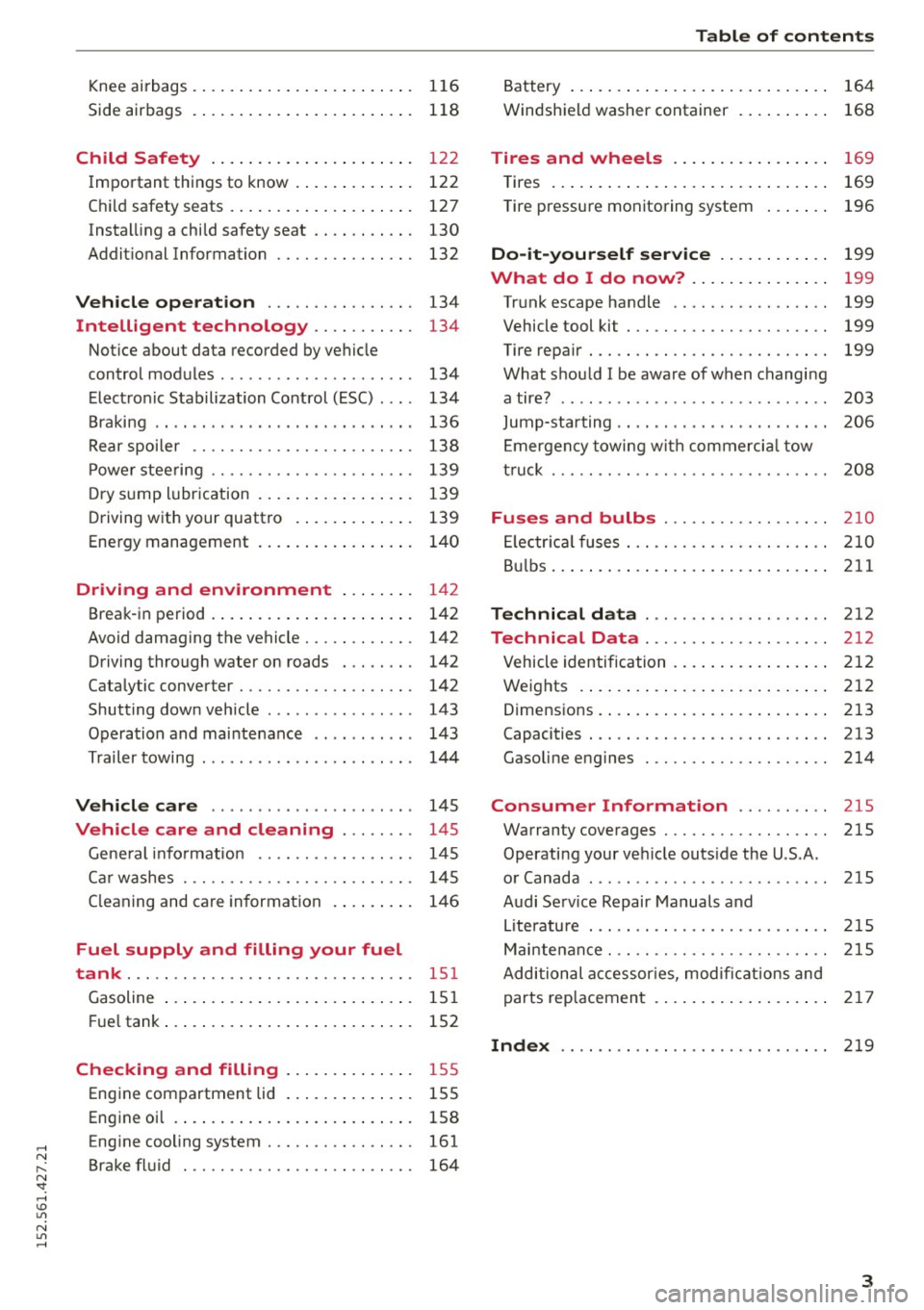
..... N
r-N "': ..... \!) 1.1'1
N 1.1'1 .....
Kneeairbags .. ........... .. .. .. .. ... 116
Side airbags . . . . . . . . . . . . . . . . . . . . . . . . 118
Ch ild Safety . . . . . . . . . . . . . . . . . . . . . . 122
Important things to know . . . . . . . . . . . . . 122
C hild safety seats . . . . . . . . . . . . . . . . . . . . 127
Instal ling a chi ld safety seat . . . . . . . . . . . 130
Additional Information . . . . . . . . . . . . . . . 132
Vehicle operation . . . . . . . . . . . . . . . . 134
Intelligent technology . . . . . . . . . . . 134
Notice about data recorded by vehicle
control modules . . . . . . . . . . . . . . . . . . . . . 134
Electronic Stabilization Control (ESC) . . . . 134
Braking . . . . . . . . . . . . . . . . . . . . . . . . . . . . 136
Rear spoiler . . . . . . . . . . . . . . . . . . . . . . . . 138
Power steering . . . . . . . . . . . . . . . . . . . . . . 139
D ry s ump lubr ication . . . . . . . . . . . . . . . . . 139
Driving with your quattro . . . . . . . . . . . . . 139
Energy management . . . . . . . . . . . . . . . . . 140
Driving and environment . . . . . . . . 142
Break-in period . . . . . . . . . . . . . . . . . . . . . . 142
Avoid damaging the vehicle . . . . . . . . . . . . 142
Driving through water on roads . . . . . . . . 142
Catalytic converter . . . . . . . . . . . . . . . . . . . 142
Shutting down vehicle . . . . . . . . . . . . . . . . 143
Operation and maintenance . . . . . . . . . . . 143
Trailer towing . . . . . . . . . . . . . . . . . . . . . . . 144
Vehicle care . . . . . . . . . . . . . . . . . . . . . . 145
Vehicle c are and cleaning . . . . . . . . 145
General information . . . . . . . . . . . . . . . . . 145
Car washes . . . . . . . . . . . . . . . . . . . . . . . . . 145
Cleaning and care information . . . . . . . . . 146
Fuel supply and filling your fuel
tank ... .. .. .... ............. .. .. .. .
151
Gasoline . . . . . . . . . . . . . . . . . . . . . . . . . . . 151
Fu el tank . . . . . . . . . . . . . . . . . . . . . . . . . . . 152
Checking and filling . . . . . . . . . . . . . . 155
Engine compartment lid . . . . . . . . . . . . . . 155
Engine oil . . . . . . . . . . . . . . . . . . . . . . . . . . 158
Eng ine cooling system . . . . . . . . . . . . . . . . 161
Brake fl uid . . . . . . . . . . . . . . . . . . . . . . . . . 164
Table of contents
Battery . . . . . . . . . . . . . . . . . . . . . . . . . . . . 164
Windshield washer container . . . . . . . . . . 168
Tires and wheel s . . . . . . . . . . . . . . . . . 169
Tires . . . . . . . . . . . . . . . . . . . . . . . . . . . . . . 169
Tire pressure monitoring system . . . . . . . 196
Do-it-yourself service . . . . . . . . . . . . 199
What do I do now? . . . . . . . . . . . . . . . 199
Trunk escape handle . . . . . . . . . . . . . . . . . 199
Vehicle tool kit . . . . . . . . . . . . . . . . . . . . . . 199
Tire repair . . . . . . . . . . . . . . . . . . . . . . . . . . 199
What should I be aware of when changing
a tire? . . . . . . . . . . . . . . . . . . . . . . . . . . . . . 203
Jump-starting . . . . . . . . . . . . . . . . . . . . . . . 206
Emergency towing with commercial tow
truck . . . . . . . . . . . . . . . . . . . . . . . . . . . . . . 208
Fu ses and bulb s . . . . . . . . . . . . . . . . . . 210
El ectr ical fuses . . . . . . . . . . . . . . . . . . . . . . 210
Bulbs......... .. .. ........... .. .. .. 211
Technical data . . . . . . . . . . . . . . . . . . . . 212
Technical Data . . . . . . . . . . . . . . . . . . . . 212
Vehicle identification . . . . . . . . . . . . . . . . . 2 12
Weights . . . . . . . . . . . . . . . . . . . . . . . . . . . 212
Dimensions......................... 213
Capacities . . . . . . . . . . . . . . . . . . . . . . . . . . 213
Gasoline engines . . . . . . . . . . . . . . . . . . . . 214
Consumer Information . . . . . . . . . . 215
Warranty coverages . . . . . . . . . . . . . . . . . . 21S
Operating your vehicle outside the U.S.A .
o r Canada . . . . . . . . . . . . . . . . . . . . . . . . . . 21S
Audi Servi ce Repair Manuals and
Literature . . . . . . . . . . . . . . . . . . . . . . . . . . 215
Maintenance. .. .. ... .......... .. .. .. 215
Additional accessor ies, modifications and
parts replacement 217
Index . . . . . . . . . . . . . . . . . . . . . . . . . . . . . 219
3
Page 58 of 232
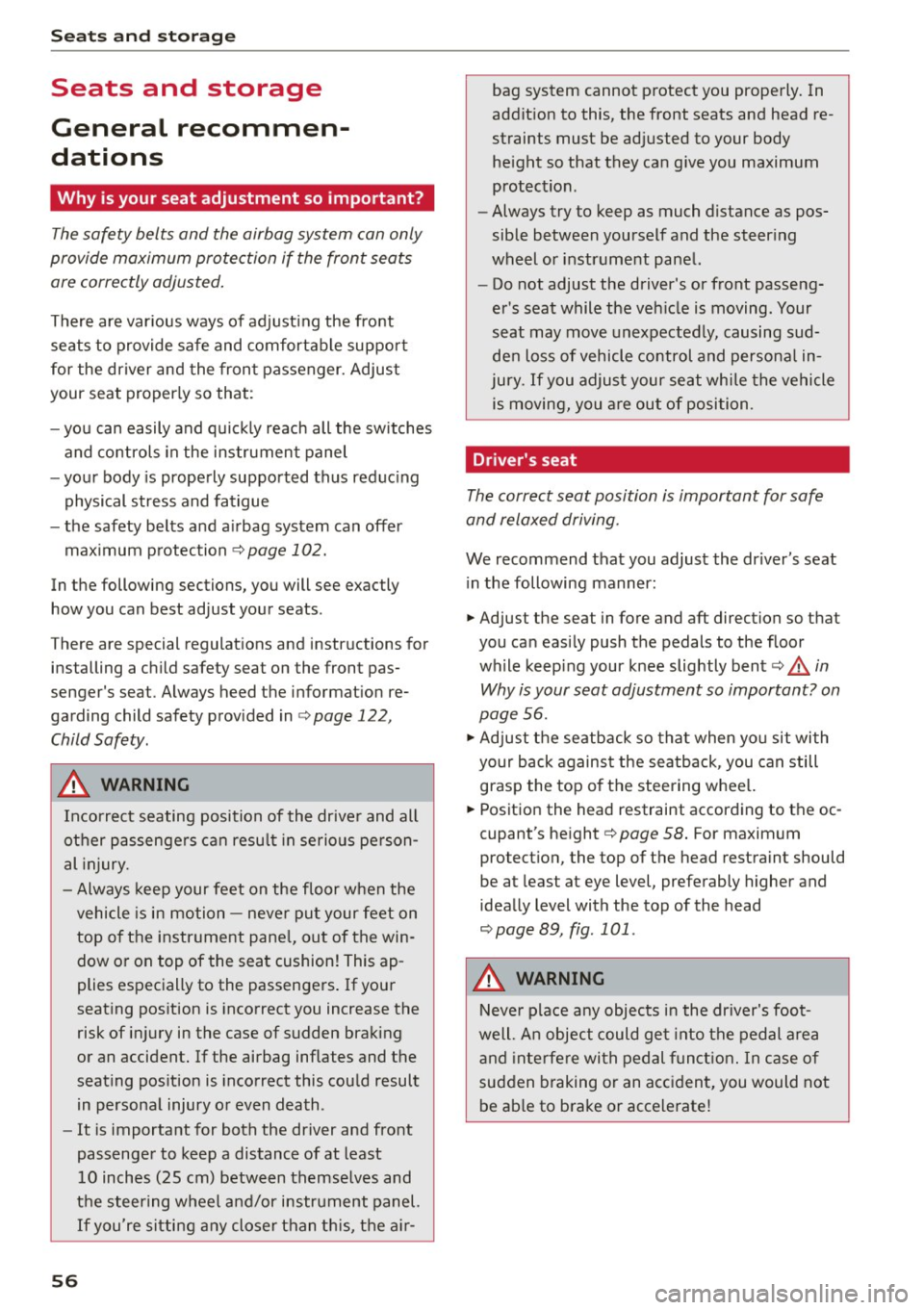
Seat s and storage
Seats and storage
General recommen
dations
Why is your seat adjustment so important?
The safety belts and the airbag system can only
provide maximum protection if the front seats are correctly adjusted.
There are var ious ways of adjust ing the front
seats to provide safe and comfortable suppo rt
for the driver and the front passenger. Adjust
your seat properly so that :
- you can easily and quick ly reach all the switches
and controls in the instrument panel
- your body is prope rly supported thus reduc ing
physical stress and fatigue
- the safety belts and a irbag system can offer
maximum p rotection
<> page 102.
In the following sections, you will see exactly
how you can best ad just your seats .
There are special regulat ions and inst ructions for
installing a c hild safety seat on the front pas
senger 's seat . Always heed the informat ion re
garding child safety prov ided in<>
page 122 ,
Child Safety.
_& WARNING
Incorrect seating position of the drive r and all
other passenge rs can resu lt in serious pe rson
al injury.
- Always keep your feet on the floor when the
vehicle is in m otion -neve r put your feet on
top of the instrument pane l, out of the win
dow or on top of the sea t cushion! This ap
plies es pecially to the passenge rs . If you r
seat ing pos ition is incorrect you increase the
risk of injury in the case of sudden bra king
or an accident. If the airbag inflates and the
seat ing pos ition is incorrect this cou ld result
in persona l injury o r even dea th .
- It is important for both the driver and front
passenge r to keep a distance of at least
10 inches (25 cm) between themselves and
t h e steering wheel and/or instrument panel.
If you're sitting any closer than th is, t he a ir-
56
bag system cannot p rotect you properly. In
addit ion to this, the front seats and head re
straints must be adjusted to your body he ight so that they can g ive you maximum
protection.
- Always try to keep as much distance as pos
sible between yourself and the steer ing
wheel or instrument pane l.
- Do not adjust the driver's or front passeng
er's seat while the veh icle is moving . Your
seat may move unexpected ly, causing sud
den loss of vehicle control and persona l in
jury.
If you adju st your seat while the vehicle
is moving, you are out of position .
Driver's seat
The correct seat position is important for safe
and rela xed driving .
We recommend that you adjust the dr iver's seat
i n the following manner:
.,. Adjust the seat in fore and aft direction so t hat
you ca n eas ily push the pedals to the floor
wh ile keep ing your knee slightly bent¢.&.
in
Why is your seat adjustment so important? on
page 56.
.,. Adjust the se atb ack so tha t when yo u sit wi th
your back agains t the sea tback, you ca n still
grasp the top of the steering whee l.
.,. Posit ion the head restraint according to the oc
cupant's he ight ¢
page 58. For maximum
protect ion, the top of the head restraint should
be at least at eye level, preferably higher and
idea lly level with the top of the head
¢ page 89, fig . 101 .
_& WARNING
Neve r place any objects in the dr iver's foo t
well. An object could ge t into t he pedal are a
a nd in te rfere wi th pedal fun ct ion . In case o f
sud den braking or an acc ident, you wou ld not
be ab le to b rake or accele rate!
-
Page 59 of 232
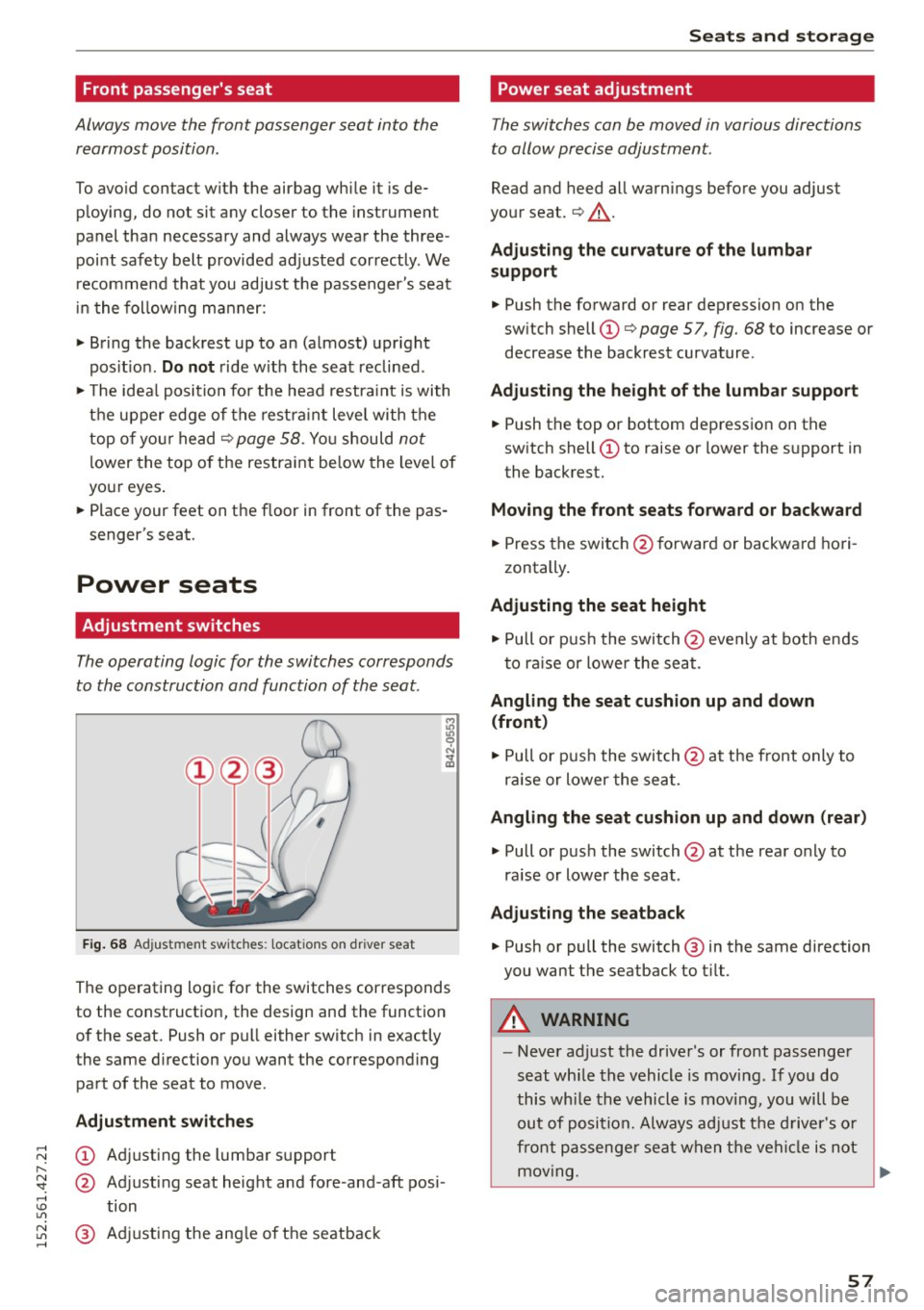
Front passenger's seat
Always move the front passenger seat into the rearmost position.
To avoid contact wit h the airbag while it is de
p loying, do not sit any closer to the instrume nt
panel than necessary and always wear the three
point safety belt provided adjusted correctly . We
recommend that you adjust the passenger's seat
i n the following manner:
"' Bring the backrest up to an (almost) upr ight
pos it ion.
Do not ride w ith the seat reclined .
"'T he idea l position fo r the head restra int is with
the upper edge of the rest ra int level with the
top o f you r head¢
page 58. Yo u should not
lower the top o f the restraint be low the level of
your eyes .
"' Place your feet on the f loor in front of the pas
senger's seat.
Power seats
Adjustment switches
The operating logic for the switches corresponds
to the construction and function of the seat.
F ig . 68 Ad just men t sw it ches: locat ions on driver seat
The operating logic for the switches corresponds
to the const ruction, the design and the function
of the seat. Push or pull either switch in exactly
the same direction you want the corresponding pa rt of the seat to move .
Adjustment switches
~ (I) Adjusting the lumbar s upport
r--
~ @ Adjusting seat height and fore-and -aft posi-,....,
S eat s and stor age
Power seat adjustment
The switches can be moved in various directions
to allow precise adjustment.
Read and heed all warnings before you adjust
your seat.¢ ,&..
Adju sting the cur vatur e of the lumbar
support
"' Push the forward or rear depression on the
sw itch shell (I)¢
page 5 7, fig. 68 to increase or
decrease the backrest curvature .
Adjusting the height of the lumbar support
"' Push the top or bottom depression on the
sw itch shell (I) to raise or lower the s upport in
the backrest.
Moving the front seat s forward or backward
"' Press the switch @forward or backwa rd hori
zontally.
Ad justing the seat height
"' Pull or pus h the switch @eve nly at both ends
t o ra ise or lowe r the sea t.
Angling the seat cushion up and down
(front )
"' Pull or pus h the switch @at t he front only to
ra ise or lower the sea t.
Angling the seat cushion up and down (rear)
"' Pull or push the switch @at the rear o nly to
ra ise or lower the seat .
Adjusting the seatback
"' Push or pull the switch @ in the same direction
you want the seatback to t ilt.
A WARNING
--- Never adjust the driver's or front passenger
seat whi le the vehicle is moving. If you do
this whi le the vehicle is moving, you will be
ou t of position. Always ad just the d river 's o r
fr ont p assenge r seat w hen t he vehi cle is not
mov ing.
~
57
Page 60 of 232
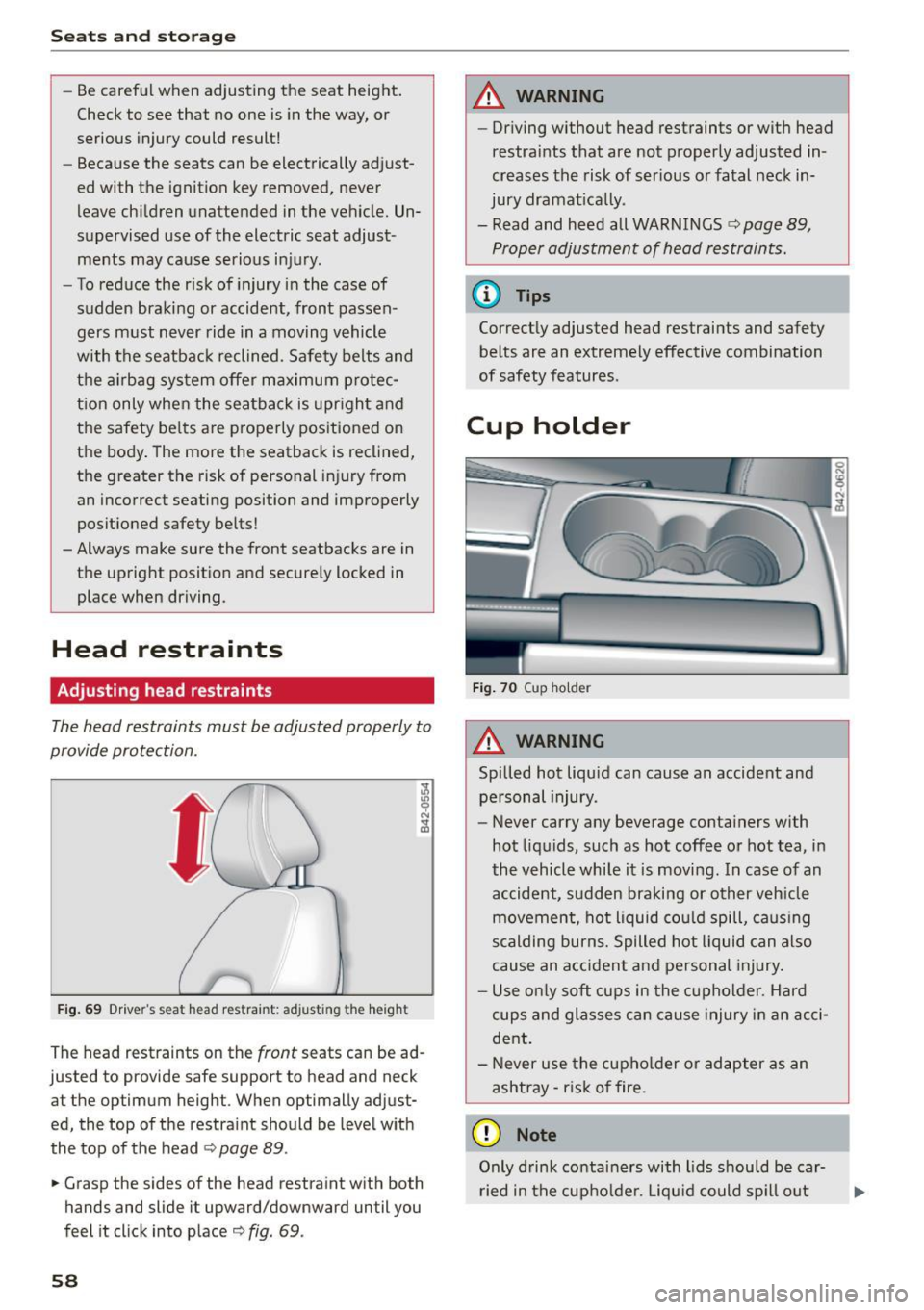
Seats and storag e
-Be careful when adjusting the seat height.
Check to see that no one is in the way, or
serious injury could result!
- Because the seats can be electrically adjust
ed with the ignition key removed, never
leave children unattended in the vehicle. Un
supervised use of the electric seat adjust
ments may cause serious inj ury.
- To reduce the r isk of injury i n the case of
sudden braking or accident, front passen gers must never ride in a mov ing vehicle
with the seatback reclined. Safety belts and
t h e a irbag sys tem offer maximum protec
t ion only when the seatback is upr ight and
the safety be lts are properly positioned on
the body . The more the seatback is reclined,
the greater the risk of personal in ju ry from
an incorrect seating position and improperly
positioned safety be lts!
- Always make sure the front seatbacks are in
th e upright posit io n and securely locked in
place when driving.
Head restraints
Adjusting head restraints
The head restraints must be adjusted properly to
provide protection.
F ig. 69 Drive r"s seat head restraint : adjusting the height
The head restraints on the front seats can be ad
justed to provide safe support to head and neck
at the optimum height . When optimally adjust
ed, the top of the restra int should be leve l w ith
the top of the head
¢ page 89 .
• Grasp the sides of the head restraint with both
hands and slide it upward/downward until you
feel it click into place
¢ fig . 69.
58
A WARNING
-Dr iving without head restraints or with head
restraints that are not properly adjusted in
creases the risk of ser ious or fatal neck in
jury dramat ically.
- Read and heed all WARNINGS
<=> page 89,
Proper adjustment of head restraints.
@ Tips
Correct ly adjusted head restraints and safety
belts are an extremely effective combination
of safety features.
Cup holder
Fi g. 70 Cup ho lder
A WARNING
Spilled hot liquid can cause an accident and
personal injury.
- Never carry any beverage co nta iners with
hot liqu ids, such as hot coffee or hot tea, in
the vehicle while it is moving. In case of an
accident, s udden braking or other veh icle
movement, hot liquid cou ld spill, caus ing
scalding burns. Spilled hot liquid can also
cause an acciden t and personal injury.
- Use on ly soft cu ps in the cupholder. Hard
cups and glasses can cause injury in an acci
dent .
- Never use the cup holder or ad apter as an
ashtray -risk o f fire.
(D Note
Only d rink contai ne rs with lids should be car
r ied in the cupho lde r. Liqu id could sp ill out
-
Page 61 of 232
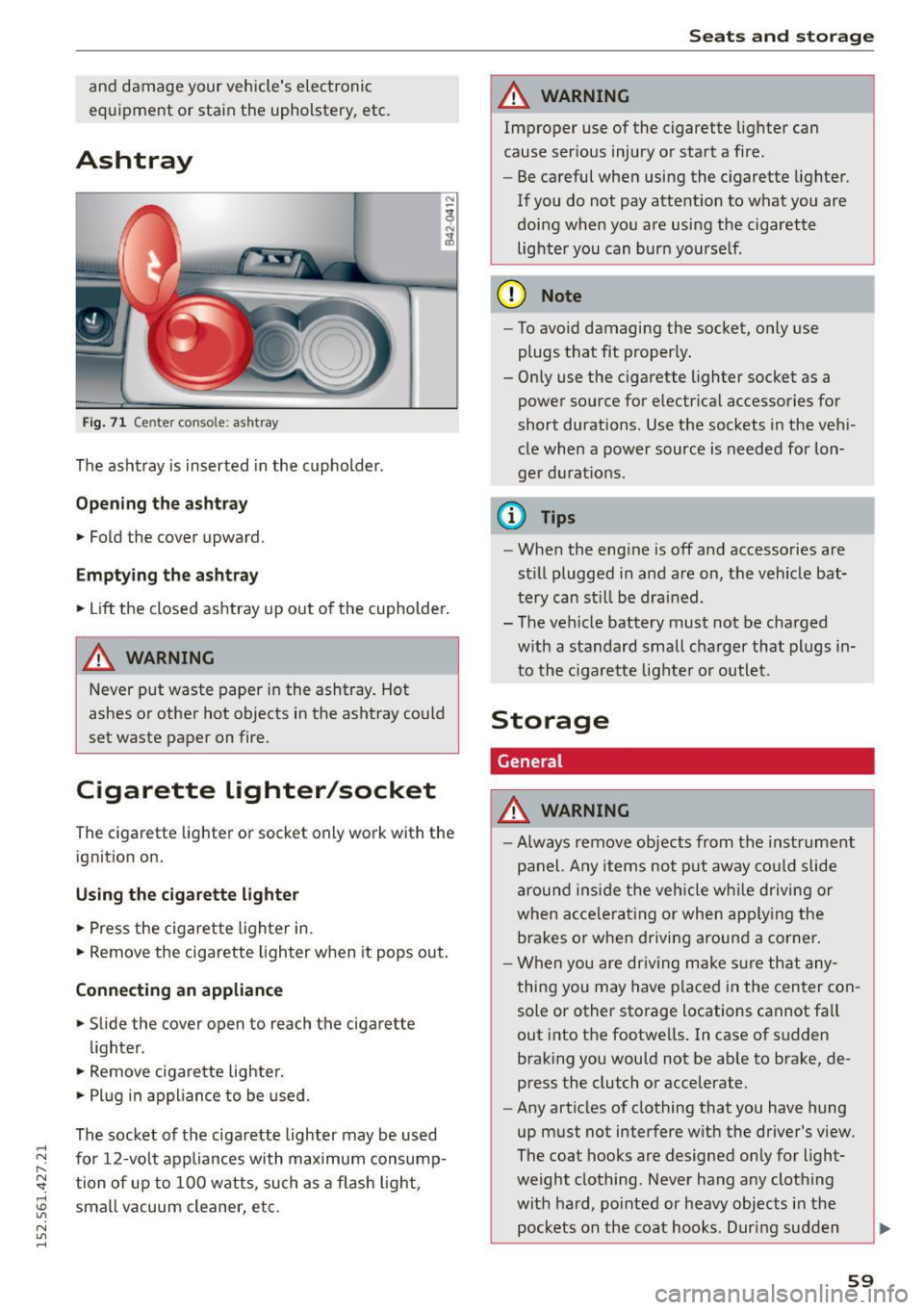
.... N
l'
N "1: rl I.O
"' N
"' ....
and damage your vehicle's electronic
equipment or stain the upholstery, etc.
Ashtray
F ig . 71 Cen te r co nsole: ash tray
The ashtray is inserted in the cupholder.
Opening the a shtra y
• Fold the cover upward.
Emptying the ashtray
• Lift the closed ashtray up out of the cupholder .
A WARNING
-
Never put waste paper in the ashtray. Hot
ashes or other hot objects in the ashtray could
set waste paper on fire.
Cigarette lighter/socket
The cigarett e lighter o r socket only work with the
ignit ion on.
Using the cigar ett e lig hter
• Press the cigarette lighter in .
• Remove the cigarette ligh ter when it pops out.
Conn ecting an appliance
• Slide the cover open to reach the cigarette
lighter .
• Remove cigare tte lighte r.
• Pl ug in appliance to be used.
The socket of the cigarette lighter may be used
for 12-volt appliances with maximum consump· tion of up to 100 watts , such as a flash light,
small vacuum cleaner, etc.
Seats and storage
A WARNING
-Improper use of the cigarette lighter can
cause ser ious injury o r start a f ire.
- Be careful when using the c igarette Lighter.
If you do not pay attention to what you are
doing when you are using the cigarette
lighter you can bur n yourse lf .
(D Note
- To avoid damaging the socket, only use
plugs that fit proper ly.
- Only use the cigarette lighter socket as a power source for e lectr ical accessories for
short durations. Use the sockets in the veh i
cle when a power source is needed for lon·
ger d urat ions .
(i} Tips
-When the eng ine is off and accessories are
st ill plugged in and are on, the vehicle bat·
tery can st il l be drained .
- The vehicle battery must not be charged
with a standard small charger that plugs in
to the c igarette lighte r or outlet.
Storage
General
A WARNING
=
- Always remove objects from the instrument
panel. Any items not put away co uld slide
around ins ide the veh icle w hile driving or
when accele rating o r when app ly ing the
brakes or when driving around a corner .
- When you are dr iv ing make s ure that any
thing you may have placed in the center con
sole or other storage locations cannot fa ll
out into the footwe lls. I n case of sudden
braking you would not be ab le to brake, de
press the clutch or accelerate.
- Any articles of clothing that you have hung
up must not interfere with the driver's view .
The coat hooks are designed only for light·
weight clothing . Never hang any clothing
with ha rd, po inted or heavy objects i n the
pockets on the coat hooks. Dur ing sudden ..,.
59
Page 62 of 232
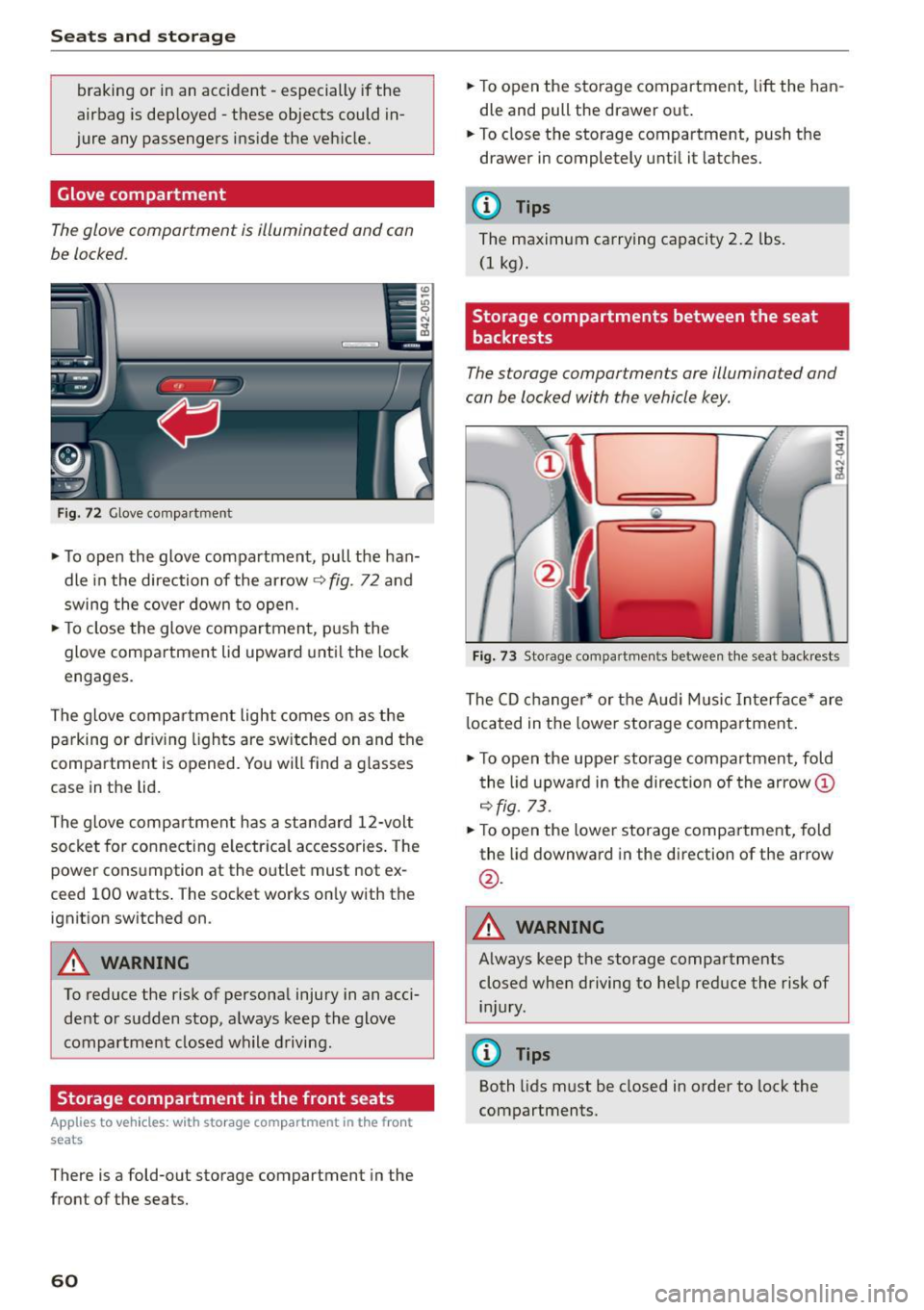
Seats and storag e
braking or in an accident -especially if the
airbag is dep loyed -these objects could in
jure any passengers ins ide the vehicle.
Glove compartment
The glove comportment is illuminated and con
be locked.
F ig. 72 Glove compartment
.,. To open the glove compartment, pull the han
dle in the direction of the arrow
9 fig. 72 and
swing the cove r down to open .
.,. To close the glove compartment, p us h the
glove compartment lid upward unti l the lock
engages.
The glove compartment light comes on as the parking or dr iving lights are switched on and the
compartment is opened. You will find a g lasses
case in the lid.
The glove compartment has a standard 12-volt socket for co nnecting e lectrica l accessories . The
power cons umption at the outlet must not ex
ceed 100 watts . The socket works on ly with the
ignition switched on.
A WARNING
To reduce the risk of personal injury in an acci
dent o r sudden stop, a lways keep the glove
compartment closed wh ile driving .
Storage compartment in the front seats
Applies to veh icles: w ith storage compartment in the front
seats
There is a fold-out storage compartment in the
front of the seats.
60
.,. To open the storage compartment, lift the han
dle and pull the drawer out .
.,. To close the storage compartment, push the
drawer in completely until it latches.
(D Tips
The maximum carrying capacity 2.2 lbs.
(1 kg).
Storage compartments between the seat
backrests
The storage comportments ore illuminated and
con be locked with the vehicle key.
Fi g. 73 Storage compart men ts betwee n th e seat backrests
The CD changer * or t he A ud i M usic Interface* are
l ocated in the lowe r storage compartment .
.,. To open the upper storage compartment, fold
t he lid upward in the direc tion of the arrow@
9fig. 73 .
.,. To open the lower storage compartment, fold
the lid downward in the direction of the arrow
@ .
A WARNING -
Always keep t he storage compartments
closed when driving to help reduce the risk of i n jury.
(D Tips
Both lids m ust be closed in order to lock the
compartments.
Page 66 of 232
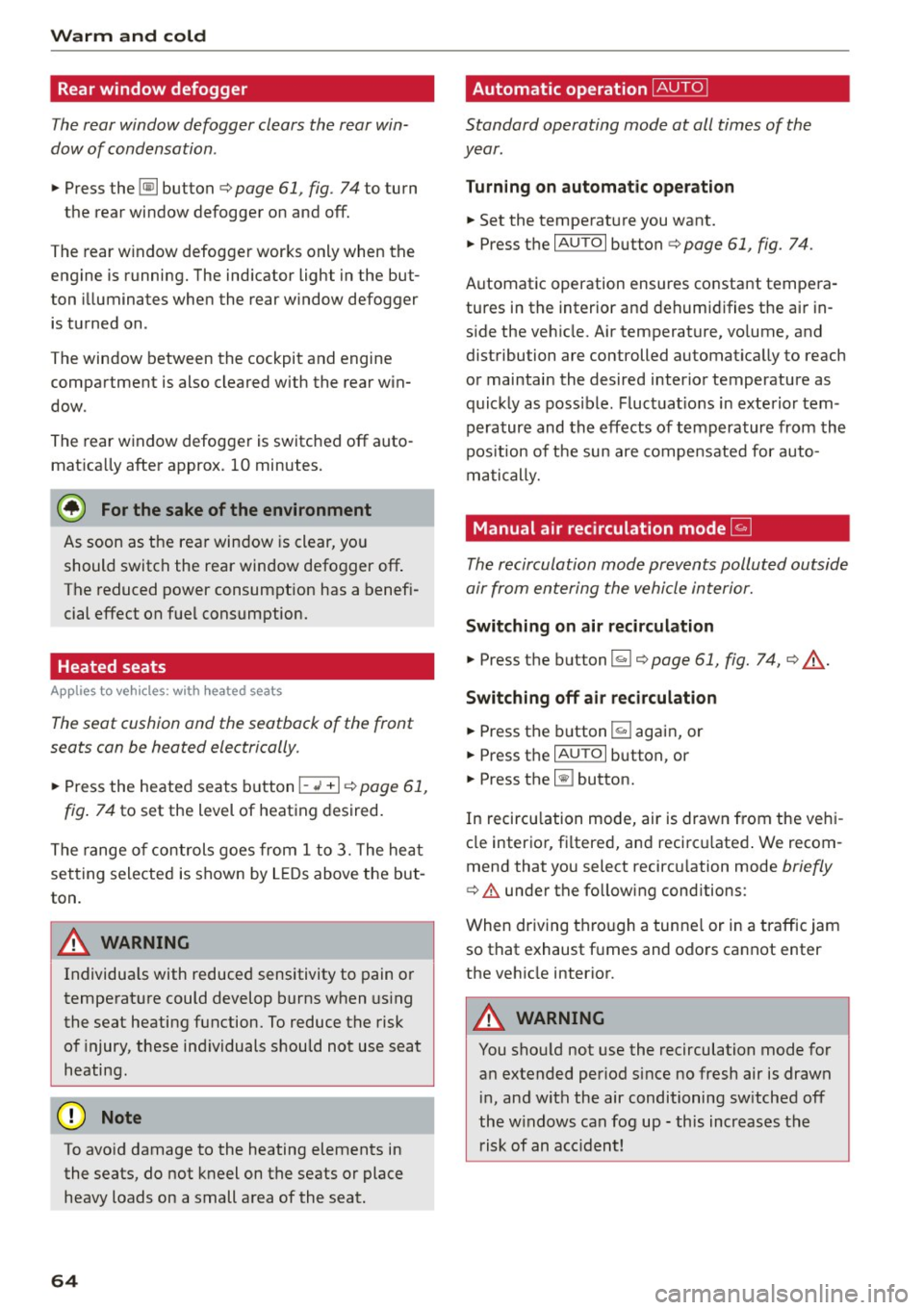
Warm and cold
Rear window defogger
The r ear window d efogger clears th e re ar win
dow of cond ensation .
.,. Press the~ button c:;, page 61, fig . 74 to turn
the rear window defogger on and off.
The rear w indow defogger works only when the
engine is running. The indicator light in the but
ton illuminates when the rear window defogger
is turned on .
The window between the cockpit and engine
compartment is also cleared with the rear w in
dow.
The rear window defogger is switched off auto
mat ica lly after approx. 10 minutes.
@ For the sake of the environment
As soon as the rea r window is clear, yo u
should switch the rear window defogger off .
The reduced power consumpt ion has a benef i
cial effect on f uel consumption.
Heated seats
A pp lies to veh icles: w ith heated seats
The seat cushion and the seatback of the front
seats can be heated electrically.
.,. Press the heated sea ts b utton I-J + I c:;, page 61,
fig . 74
to set the level of heat ing des ired.
T he range o f control s goes from 1 to 3. The he at
set ting selected is shown by LEDs above the but
ton.
_& WARNING
Individua ls with reduced sensitivity to pain o r
tempe rat ure could develop burns when us ing
the seat heating function. To reduce the risk
o f i njury, these ind iv iduals s hould n ot use seat
heating.
@ Note
To avo id damage to the heating elements in
the seats, do not kneel on the seats o r place
heavy loads on a small a rea of the seat.
64
Automatic operation ~
Standard operating mode at all times of the
year .
Turning on automat ic oper ation
.,. Set the temperat ure you want .
.,. Press the
IAUTO I button c:;, page 61, fig. 74.
Automat ic operation ensures constant tempera
tures in the interior and dehumidifies the air in
s ide the veh icle. Air temperature, vo lume, and
distribution are controlled automatically to reach
or maintain the desired interio r temperature as
quic kly as possible. Fluc tuat io ns in exterio r tem
perature and the effects of temperature from the
pos it ion of t he sun are compe nsated for auto
matically.
Manual air recirculation mode~
The recirculation mode prevents polluted outside
air from entering the vehicle in te rior.
Switching on air recirculation
.,. Press the button~ c:;, page 61, fig. 74, c:;, _&.
Switching off air recirculation
.,. Press the button ~ again, or
.,. Press the
IAUTO I button, or
.,. Press the~ button .
I n recircu lation mode, air is drawn from the ve hi
cle inter io r, fil tered, an d recirc ulated . We recom
mend that you select recirculation mode
briefly
c:;, .&. under the following conditions:
When driving thro ugh a tunne l or in a traffic jam
so that exhaust f umes and odo rs ca nnot enter
the ve hicle interio r.
A WARNING
You sho uld not use the recirculation mode for
a n extended period si nce no fresh air is drawn
i n , and with th e air conditioning sw itched off
the w indows c an fo g up - th is increases the
risk of an ac cident!
Page 88 of 232
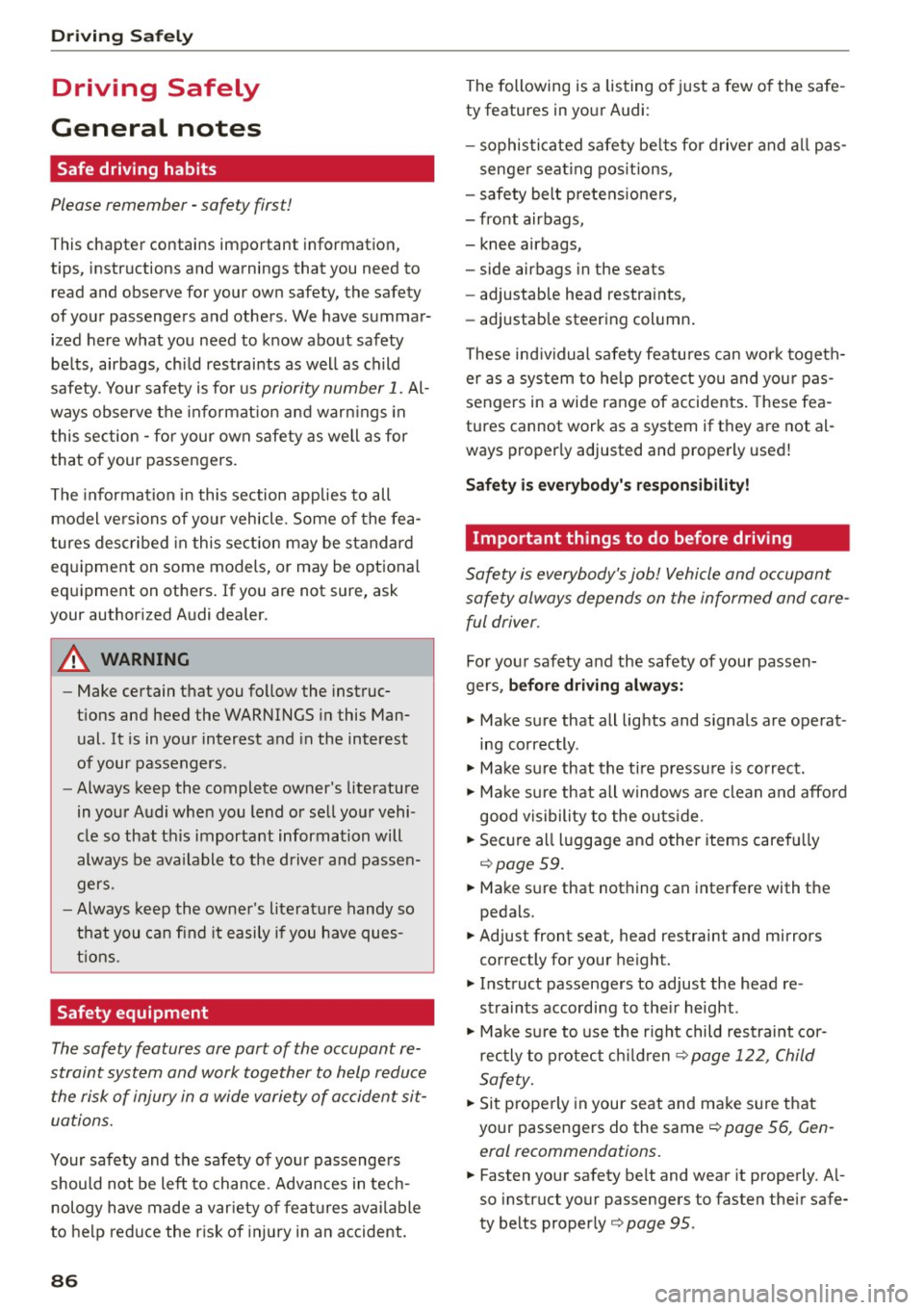
Driving Sa fel y
Driving Safely
General notes
Safe driving habits
Please remember -safety first!
This chapter contains important information,
tips, instructions and warnings that you need to
read and observe for your own safety, the safety
of your passengers and others. We have summar
ized here what you need to know about safety
be lts, airbags, chi ld restraints as well as child
safety. Your safety is for us
priority number 1 . Al
ways observe the informat ion and warn ings in
t his section - for your own safety as well as for
that of your passengers.
The information i n this section applies to all
model ve rsions of your vehicle . Some of the fea
t ures des cribed in this sect ion may be standard
equipment on some models, or may be optional
eq uipment on others . If you are not sure, ask
your author ized Audi dealer.
A WARNING
-Make certain that you fo llow the instruc
t ions and heed the WARNINGS in this Man
ual. It is in your interest and in the interest
of your passengers .
- Always keep the complete owner's literature
in your Audi when you lend or se ll you r vehi
cle so that this important information will
always be ava ilable to the driver and passen
gers.
- Always keep the owner's literature handy so
that you can find it easily if you have ques
ti ons.
Safety equipment
The safety features are part of the occupant re
straint system and work together to help reduce
the risk of injury in a wide variety of occident si t
uations.
Your safety and the safety of yo ur passengers
should not be left to chance. Advances in tec h
nology have made a var iety of f eatures av ailable
to help re duce the r isk of inj ury in an accident.
86
The following is a listing o f just a few o f the safe
ty features in yo ur Audi:
- sophis tica ted s afety be lts for drive r and a ll pas-
senger sea ting pos itions,
- safety belt p rete nsio ners,
- front airbags,
- knee airbags,
- side airbags in the seats
- adjustab le head restraints,
- adjustab le steering column .
These ind iv idual safety featu res can wor k togeth
er as a sys tem to he lp pro tect you a nd your pas
sengers in a wide range of accidents . These fea
tures cannot work as a system if th ey are not al
ways proper ly adjusted and prope rly used!
Safety i s everyb ody' s re sponsibilit y!
Important things to do before driving
Safety is everybody's job! Vehicle and occupant
safety always depends on the informed and care
ful driver.
Fo r you r safety and the safety of your passen
gers,
before driving always:
.,. Make sure that all lights and signals are operat
ing correctly .
.,. Make sure that the tire pressu re is co rrect.
.,. Ma ke s ure that all w indows are clean and affo rd
good visibility to the outs ide.
.,. Secure a ll luggage and o ther items caref ully
r=;,page 59 .
.,. Make s ure that nothing can interfere with the
pedals.
.,. Adjust front seat, head restraint and mirrors
correctly for your height.
.,. Instruct passengers to adjust the head re
straints according to the ir height .
.,. Make su re to use the r ight child restraint cor
rec tly to p rotect ch ild ren
r=;, page 122, Child
Safety.
.,. Sit p roperly in your seat and ma ke su re that
your passengers do the same
c::> page 56, Gen
eral recommendations.
.,. Fasten your safety belt and wear it properly. A l
so instruct your passengers to fasten their safe
ty belts proper ly
c::> page 95 .
Page 90 of 232
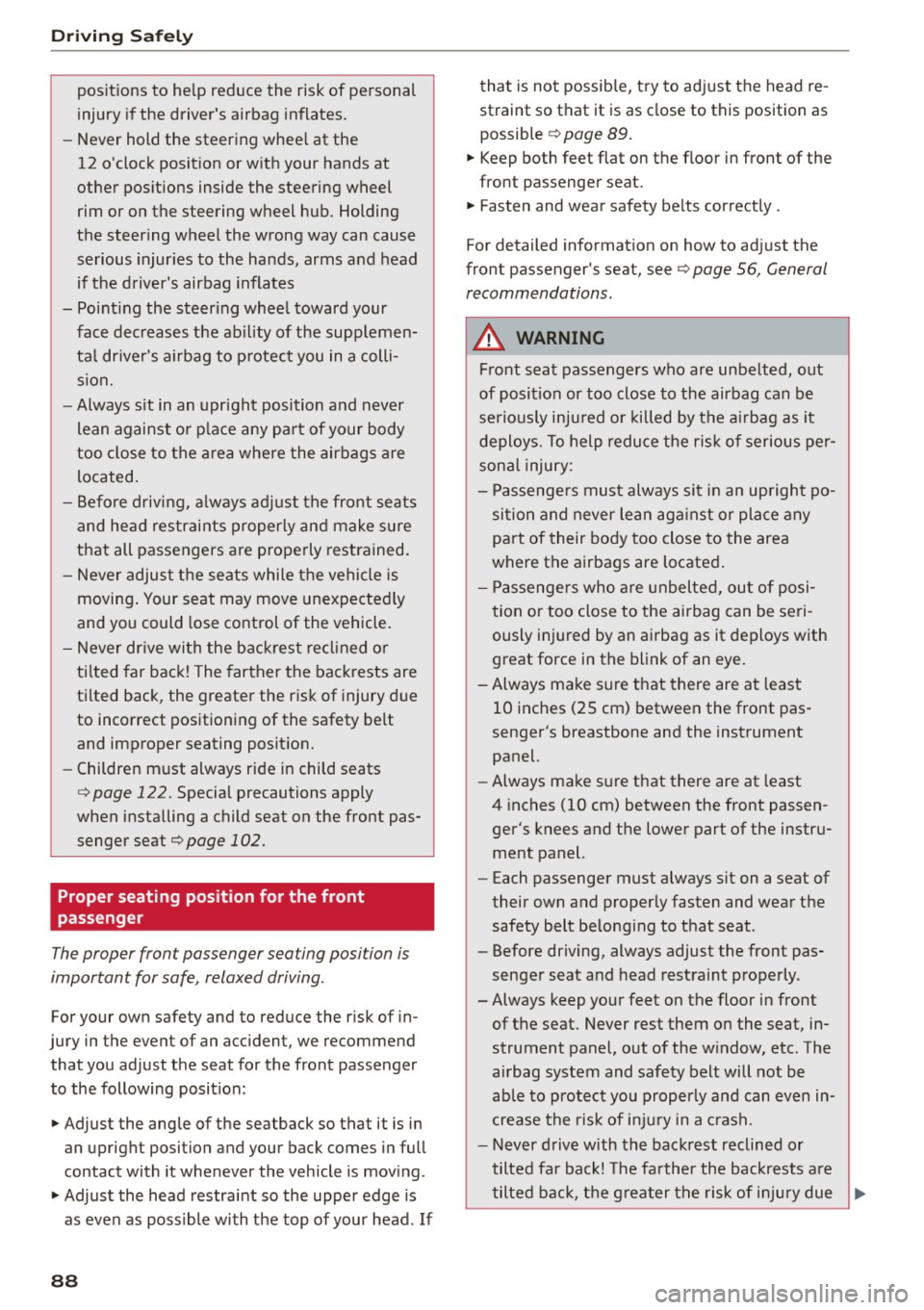
Driving Safely
positions to help reduce the risk of personal
injury if the driver's airbag inflates.
- Never hold the steering wheel at the
12 o'clock position or with your hands at
other positions inside the steering wheel
rim or on the steering wheel hub. Holding
the steering wheel the wrong way can cause
serious injuries to the hands, arms and head
if the driver's airbag inflates
- Pointing the steering wheel toward your
face decreases the ability of the supplemen
tal driver's airbag to protect you in a colli
sion.
-Always sit in an upright position and never
lean against or place any part of your body
too close to the area where the airbags are
located.
- Before driving, always adjust the front seats
and head restraints properly and make sure
that all passengers are properly restrained.
- Never adjust the seats while the vehicle is
moving. Your seat may move unexpectedly
and you could lose control of the vehicle.
- Never drive with the backrest reclined or
tilted far back! The farther the backrests are
tilted back, the greater the risk of injury due
to incorrect positioning of the safety belt and improper seating position.
- Children must always ride in child seats
¢page 122. Special precautions apply
when installing a child seat on the front pas
senger seat
¢page 102.
Proper seating position for the front
passenger
The proper front passenger seating position is
important for safe, relaxed driving .
For your own safety and to reduce the risk of in
jury in the event of an accident, we recommend
that you adjust the seat for the front passenger
to the following position:
.. Adjust the angle of the seatback so that it is in
an upr ight position and your back comes in full
contact with it whenever the vehicle is moving .
.,. Adjust the head restraint so the upper edge is
as even as possible with the top of your head. If
88
that is not possible, try to adjust the head re
straint so that it is as close to this position as
possible
¢ page 89.
.. Keep both feet flat on the floor in front of the
front passenger seat.
.. Fasten and wear safety belts correctly .
For detailed information on how to adjust the
front passenger's seat, see
¢ page 56, General
recommendations.
A WARNING
Front seat passengers who are unbelted, out
of position or too close to the airbag can be
seriously injured or killed by the airbag as it
deploys. To help reduce the risk of serious per
sonal injury:
- Passengers must always sit in an upright po
sition and never lean against or place any
part of their body too close to the area
where the airbags are located.
- Passengers who are unbelted, out of posi
tion or too close to the airbag can be seri
ously injured by an airbag as it deploys with
great force in the blink of an eye.
-Always make sure that there are at least 10 inches (25 cm) between the front pas
senger's breastbone and the instrument panel.
- Always make sure that there are at least
4 inches (10 cm) between the front passen
ger's knees and the lower part of the instru ment panel.
- Each passenger must always sit on a seat of
their own and properly fasten and wear the
safety belt belonging to that seat.
- Before driving, always adjust the front pas
senger seat and head restraint properly.
- Always keep your feet on the floor in front
of the seat. Never rest them on the seat, in
strument panel, out of the window, etc. The
airbag system and safety belt will not be
able to protect you properly and can even in
crease the risk of injury in a crash .
- Never drive with the backrest reclined or
tilted far back! The farther the backrests are
tilted back, the greater the risk of injury due
~